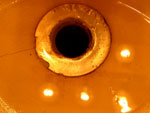Dear Umbra:
When my garbage disposal died recently, I replaced it with a clever new design that uses no electricity (just water pressure), but it led me to wonder which is really kinder to the environment: putting kitchen waste in the disposal or just trashing it? I compost whenever possible, of course, but there are always scraps that are mixed with animal fat and shouldn’t be added to a compost pile. How does the damage of this organic waste taking up space in a landfill and emitting methane to speed global warming compare to whatever happens to it when sent to a water treatment plant or a septic system? Does it end up adding excess nutrients to the water? Are disposals one of those modern “conveniences” we’d be better off without?
Richard
Newburyport, Mass.
Dearest Richard,
This question was one of the first I received when we started this column almost a year ago, and, like the hand-drying, it appears to be somewhat of an obsession with my readership. As a warm-up for our First Anniversary Event, and in a continued effort to Cheer Us All Up, I am finally going to take it on.

Drain candy.
I personally find garbage disposals kind of terrifying. They just seem like an accident waiting to happen from a bad First Aid video: “Honey, wait, don’t stick your hand down there, I’ll get you another fork!” But what does the environment think of disposals?
Your question outlines the intrinsic problems of food-waste disposal, a solid-waste issue of concern to municipalities with limited landfill space, limited sewer space, and limited water. Food waste makes up about 11 percent of garbage nationally. The bulk of that is uneaten food from culinary establishments, but some of it comes from the home kitchen. Other than eating less food, what can we do?
Home composting is the best choice, of course. It keeps trash out of the waste stream, uses no chemicals, and enriches garden soil. Alas, composting is not always possible, so back to Richard’s dilemma — down the drain or in the trash? In landfills, peels, rinds, and cores have no access to oxygen and hence biodegrade very slowly. But disposals use high volumes of water, at the sink and at the sewage treatment plant. Sewage with a high organic content has a higher Biochemical Oxygen Demand, or BOD, a measurement that gauges how many chemicals are needed to clean the sewage before it is expelled from the plant into free-running bodies of water. A higher BOD means higher water use in the plant as well. Richer sewage outflow may also lead to increased algal growth in streams. Chunks of goo formerly known as breakfast also simply increase sewage volume, requiring additional sewage-treatment capacity for municipalities already struggling with funding for existing plants and thorny issues about where to site new ones.
Older, pre-disposal sewage systems may not have the right slope or capacity to handle wastewater with minestrone in it, leading to clogged pipes. Homes with septic tanks are well advised to avoid in-sink choppers, which will fill the tank quickly. To further complicate the issue, during the sewage-treatment process, large debris is removed to landfills. I can’t say whether onion skins fall into this category, but it seems likely that all roads might lead to the landfill for some food chunks.
So, there you have it: a lopsided catalog of problems that seem to point away from the insinkerator. If you can’t bear relinquishing the frightening maw of the garbage disposal, call your local sewage folks and see what they say, as these issues do vary by municipality. The answer will depend on the current configuration of sewer and solid waste problems in your area. But, as clean water comes at more and more of a premium, and as it gets harder and harder to site and operate sewage treatment plants, the likely answer will be: Put it in the garbage.
Grindingly,
Umbra


